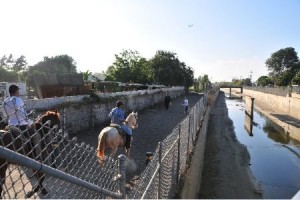Temperance, Methodists, Compton and Richland Farms
Compton is the second oldest city in Los Angeles County.*
It is named after Griffith Dickenson Compton, a Methodist minister who led a group of 30 pioneers to the area in 1867.
(At left, with his wife.)
Previously, Compton – population 96,455 in 2010 – was part of the 75,000-acre Rancho San Pedro, which was deeded in 1784 by the Spanish crown to Juan Jose Dominguez, a soldier.
The same Dominguez in today’s Dominguez Hills.
Compton and his fellow settlers had traveled by wagon train from Stockton, eager to leave the increasingly hardscrabble life of the goldfields.
Their settlement was originally called Gibsonville after one of the prior landowners. Then the temperance colony became Comptonville.
The problem was that Yuba County already had a Comptonville.
To avoid confusion, the Southern California city’s name was shortened to Compton.
Part of the attraction in leaving Stockton was finding a milder climate. Instead, initially, Compton was rainy and cold. The nearest firewood was in the mountains near Pasadena – almost a one week round trip.
But the settlers persevered. In 1887, they decided to incorporate.

Richland Farms Today
Rev. Compton donated his land to create the city but insisted that some of the acreage be dedicated to agriculture. That part of the city was called Richland Farms.
On May 18, 1888 Compton became the seventh incorporated city in the county.
Population: 500.
The first City Council meeting was held on May 14, 1888.
The reverend died in 1905 at the age of 85. Several Internet sources say Compton was one of the founders of the University of Southern California. A search of USC’s website finds no reference to a Griffith D. Compton.
While the city of Compton has changed mightily from its temperance colony roots, one part of its founder’s vision remains: Richland Farms.

A Creek Meanders through Richland Farms
The 10 square block area is one of the last residential agricultural zones in Los Angeles County. Lots are typically at least one-half acre but can be as much as a full acre. The same families have owned some of the 435 homes for decades.
There are barns. No sidewalks. Driveways lined with corn stalks.
Residents share the rural space – which is about one mile from the 91 Freeway — with a menagerie of chickens, pigs, goats, roosters, sheep and horses.
Development pressures may eventually spell the end of the unique area. In an attempt to preserve Richland Farms, some residents are seeking a”historic district” designation.
The farms is a frequent destination of “forgotten” or “undiscovered” Los Angeles walking tours.
-30-
*(El Monte is the oldest.)
Filed under: California History, News
- Capitol Cliches (16)
- Conversational Currency (3)
- Great Moments in Capitol History (4)
- News (1,288)
- Budget and Economy (383)
- California History (139)
- Demographics (11)
- Fundraising (74)
- Governor (122)
- Legislature/Legislation (270)
- Politics (173)
- State Agencies (38)
- Opinionation (36)
- Overheard (246)
- Today's Latin Lesson (45)
- Restaurant Raconteur (21)
- Spotlight (110)
- Trip to Tokyo (8)
- Venting (184)
- Warren Buffett (43)
- Welcome (1)
- Words That Aren't Heard in Committee Enough (11)

No Comments »
No comments yet.
RSS feed for comments on this post.
Leave a comment